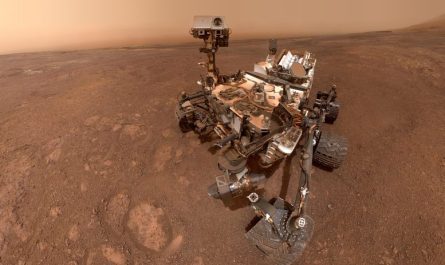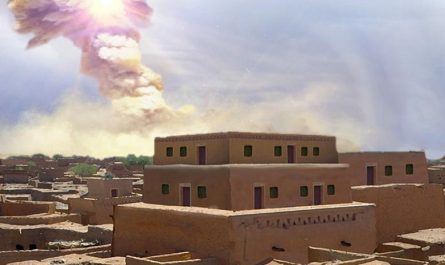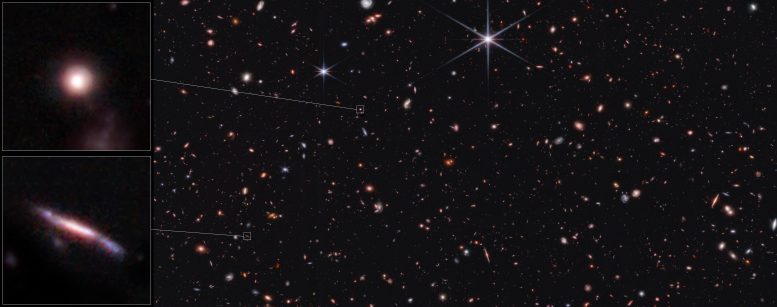

NASA’s James Webb Space Telescope has revealed that galaxies in the early universe mainly resemble elongated shapes, such as surfboards and pool noodles, rather than round forms. This finding, based on the analysis of near-infrared images from the CEERS Survey, marks a significant discovery about the structure of early galaxies and extends the insights provided by the Hubble Space Telescope. Credit: NASA, ESA, CSA, STScI, Steve Finkelstein (UT Austin), Micaela Bagley (UT Austin), Rebecca Larson (UT Austin)
Hang Ten! Researchers using Webb found that many distant galaxies have flattened oval disk and tube-like shapes, not spiral or elliptical structures.
Ready to hit the cosmic “waves” with the James Webb Space Telescope? Like a lifeguard on duty, Webb has scanned the horizon and spotted distant galaxies shaped like volleyballs, frisbees, pool noodles, and surfboards.
Researchers analyzing Webb’s data also found that the surfboard- and pool noodle-shaped galaxies were much more common when the universe was 600 million to 6 billion years old. This contrasts what we’ve previously confirmed for galaxies far closer to the “beach” with other telescopes. Nearby galaxies are often clearly defined spirals with star-studded arms, which also resemble frisbees, or smooth ellipticals, which also look like volleyballs.
It’s not yet clear if the new-to-us galaxy shapes evolved over all of cosmic time. Future research is required to tease out how galaxies’ 3D geometries transformed over more than 13 billion years.
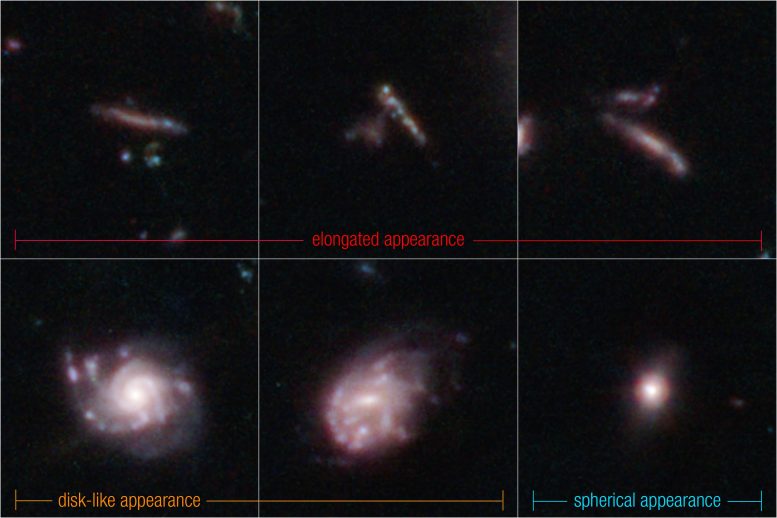

These are examples of distant galaxies captured by NASA’s James Webb Space Telescope in its Cosmic Evolution Early Release Science (CEERS) Survey.
Recent research of the CEERS field led by Viraj Pandya, a NASA Hubble Fellow at Columbia University in New York, showed that galaxies frequently appear flat and elongated, like pool noodles or surfboards (along the top row).
Thin, circular disk-like galaxies, which resemble frisbees, are the next major grouping (bottom left and center).
Finally, galaxies that are shaped like spheres, or volleyballs, made up the smallest fraction of their detections (bottom right).
All of these galaxies are estimated to have existed when the universe was 600 million to 6 billion years old.
Credit: NASA, ESA, CSA, STScI, Steve Finkelstein (UT Austin), Micaela Bagley (UT Austin), Rebecca Larson (UT Austin)
Webb Shows Many Early Galaxies Looked Like Pool Noodles, Surfboards
Researchers analyzing images from NASA’s James Webb Space Telescope have found that galaxies in the early universe are often flat and elongated, like surfboards and pool noodles – and are rarely round, like volleyballs or frisbees. “Roughly 50 to 80% of the galaxies we studied appear to be flattened in two dimensions,” explained lead author Viraj Pandya, a NASA Hubble Fellow at Columbia University in New York. “Galaxies that look like pool noodles or surfboards seem to be very common in the early universe, which is surprising, since they are uncommon nearby.”
The team focused on a vast field of near-infrared images delivered by Webb, known as the Cosmic Evolution Early Release Science (CEERS) Survey, plucking out galaxies that are estimated to exist when the universe was 600 million to 6 billion years old.
While most distant galaxies look like surfboards and pool noodles, others are shaped like frisbees and volleyballs. The “volleyballs,” or sphere-shaped galaxies, appear the most compact type on the cosmic “ocean” and were also the least frequently identified. The frisbees were found to be as large as the surfboard- and pool noodle-shaped galaxies along the “horizon,” but become more common closer to “shore” in the nearby universe. (Compare them in the illustration below.)
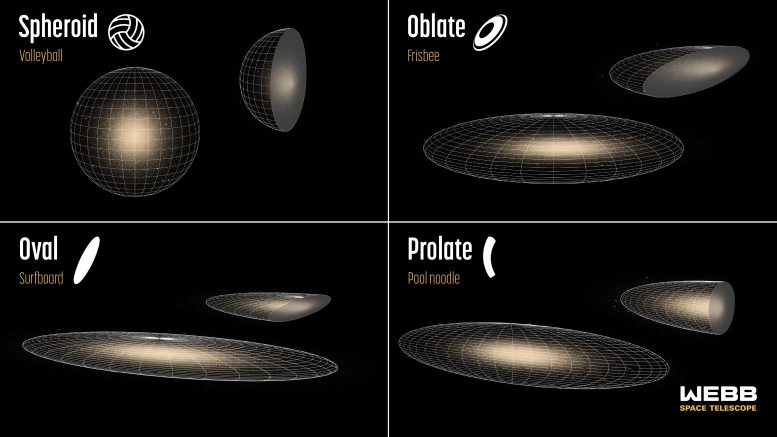

Pandya’s team pinpointed four main classifications, shown illustrated above as both 3D objects and cross sections. They are ordered from least to most frequent.
At top left, Webb’s survey shows a classification that’s rare in the early universe, but common today: Galaxies that are shaped like spheres or volleyballs.
At top right are flattened circular disks or frisbees, which are only slightly more common.
The galaxy shapes that dominate during this early period look flat and elongated, like surfboards, shown at bottom left, or pool noodles, bottom right. This pair of classifications make up approximately 50 to 80% of all distant galaxies they’ve studied so far – a surprise, since these shapes are uncommon nearby.
Credit: NASA, ESA, CSA, Joseph Olmsted (STScI), Viraj Pandya (Columbia), Haowen Zhang (University of Arizona), Lucy Reading-Ikkanda (Simons Foundation)
Which category would our Milky Way galaxy fall into if we were able to wind the clock back by billions of years? “Our best guess is that it might have appeared more like a surfboard,” said co-author Haowen Zhang, a PhD candidate at the University of Arizona in Tucson. This hypothesis is based partly on new evidence from Webb – theorists have “wound back the clock” to estimate the Milky Way’s mass billions of years ago, which correlates with shape at that time.
These distant galaxies are also far less massive than nearby spirals and ellipticals – they are precursors to more massive galaxies like our own. “In the early universe, galaxies had had far less time to grow,” said Kartheik Iyer, a co-author and NASA Hubble Fellow also at Columbia University. “Identifying additional categories for early galaxies is exciting – there’s a lot more to analyze now. We can now study how galaxies’ shapes relate to how they look and better project how they formed in much more detail.”
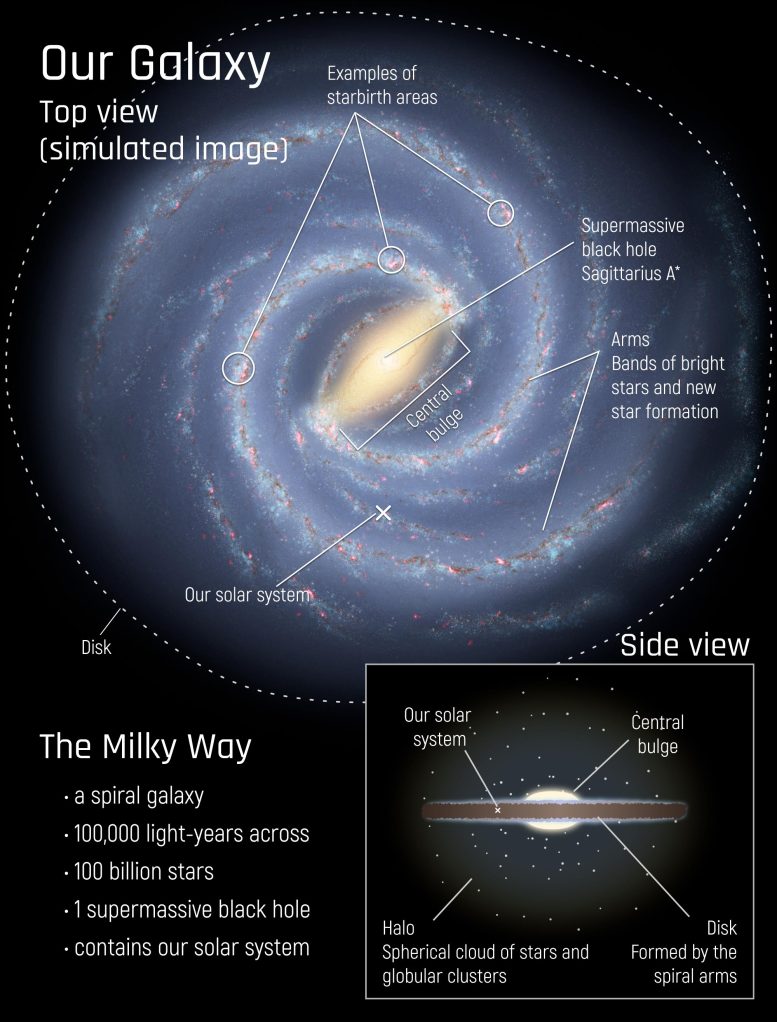

Our galaxy, the Milky Way, contains a supermassive black hole at its core surrounded by a central bulge of old, yellowish stars. Beyond that are bluish spiral arms filled with younger stars, newly forming stars, and dark lanes of dust. Credit: NASA and STScI
Webb’s sensitivity, high-resolution images, and specialization in infrared light allowed the team to make quick work of characterizing many CEERS galaxies, and model their 3D geometries. Pandya also says their work wouldn’t be possible without the extensive research astronomers have done using NASA’s Hubble Space Telescope.
For decades, Hubble has wowed us with images of some of the earliest galaxies, beginning with its first “deep field” in 1995 and continuing with a seminal survey known as Cosmic Assembly Near-infrared Deep Extragalactic Legacy Survey. Deep sky surveys like these led to far greater statistics, leading astronomers to create robust 3D models of distant galaxies over all of cosmic time. Today, Webb is helping to enhance these efforts, adding a bounty of distant galaxies beyond Hubble’s reach and revealing the early universe in far greater detail than previously possible.
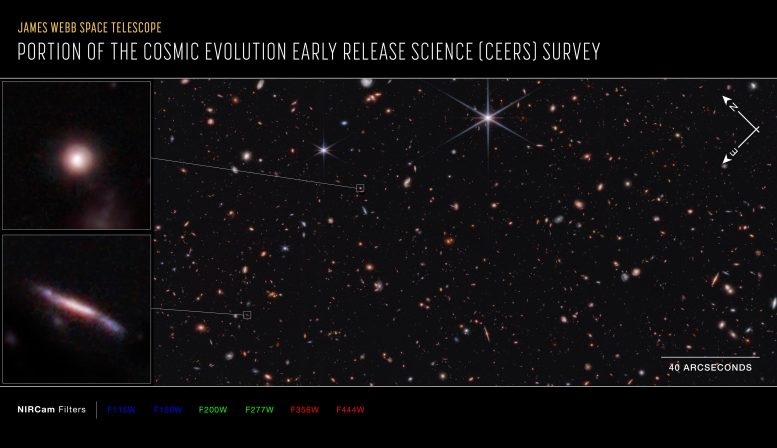

This is a portion of the Cosmic Evolution Early Release Science (CEERS) Survey, made up of several near-infrared pointings from NIRCam (the Near-Infrared Camera) aboard the James Webb Space Telescope. These observations are within the same region studied by the Hubble Space Telescope, which is known as the Extended Groth Strip.
The north and east compass arrows show the orientation of the image on the sky. Note that the relationship between north and east on the sky (as seen from below) is flipped relative to direction arrows on a map of the ground (as seen from above).
This image shows invisible near-infrared wavelengths of light that have been translated into visible-light colors. The color key shows which NIRCam filters were used when collecting the light. The color of each filter name is the visible light color used to represent the infrared light that passes through that filter.
The scale bar is labeled in arcseconds, which is a measure of angular distance on the sky. One arcsecond is equal an angular measurement of 1/3600 of one degree. There are 60 arcminutes in a degree and 60 arcseconds in an arcminute. (The full Moon has an angular diameter of about 30 arcminutes.) The actual size of an object that covers one arcsecond on the sky depends on its distance from the telescope.
Credit: NASA, ESA, CSA, STScI, Steve Finkelstein (UT Austin), Micaela Bagley (UT Austin)
Webb’s images of the early universe have acted like an ocean swell – delivering new waves of evidence. “Hubble has long showed an excess of elongated galaxies,” explained co-author Marc Huertas-Company, a faculty research scientist at the Institute of Astrophysics on the Canary Islands. But researchers still wondered: Would additional detail show up better with sensitivity to infrared light? “Webb confirmed that Hubble didn’t miss any additional features in the galaxies they both observed. Plus, Webb showed us many more distant galaxies with similar shapes, all in great detail.”
There are still gaps in our knowledge – researchers not only need an even larger sample size from Webb to further refine the properties and precise locations of distant galaxies, they will also need to spend ample time tweaking and updating their models to better reflect the precise geometries of distant galaxies. “These are early results,” said co-author Elizabeth McGrath, an associate professor at Colby College in Waterville, Maine. “We need to delve more deeply into the data to figure out what’s going on, but we’re very excited about these early trends.”
Reference: “Galaxies Going Bananas: Inferring the 3D Geometry of High-Redshift Galaxies with JWST-CEERS” by Viraj Pandya, Haowen Zhang, Marc Huertas-Company, Kartheik G. Iyer, Elizabeth McGrath, Guillermo Barro, Steven L. Finkelstein, Martin Kuemmel, William G. Hartley, Henry C. Ferguson, Jeyhan S. Kartaltepe, Joel Primack, Avishai Dekel, Sandra M. Faber, David C. Koo, Greg L. Bryan, Rachel S. Somerville, Ricardo O. Amorin, Pablo Arrabal Haro, Micaela B. Bagley, Eric F. Bell, Emmanuel Bertin, Luca Costantin, Romeel Dave, Mark Dickinson, Robert Feldmann, Adriano Fontana, Raphael Gavazzi, Mauro Giavalisco, Andrea Grazian, Norman A. Grogin, Yuchen Guo, ChangHoon Hahn, Benne W. Holwerda, Lisa J. Kewley, Allison Kirkpatrick, Anton M. Koekemoer, Jennifer M. Lotz, Ray A. Lucas, Laura Pentericci, Pablo G. Perez-Gonzalez, Nor Pirzkal, Dale D. Kocevski, Casey Papovich, Swara Ravindranath, Caitlin Rose, Marc Schefer, Raymond C. Simons, Amber N. Straughn, Sandro Tacchella, Jonathan R. Trump, Alexander de la Vega, Stephen M. Wilkins, Stijn Wuyts, Guang Yang and L. Y. Aaron Yung, Accepted, The Astrophysical Journal.
arXiv:2310.15232
The James Webb Space Telescope is the world’s premier space science observatory. Webb is solving mysteries in our solar system, looking beyond to distant worlds around other stars, and probing the mysterious structures and origins of our universe and our place in it. Webb is an international program led by NASA with its partners, ESA (European Space Agency) and the Canadian Space Agency.


